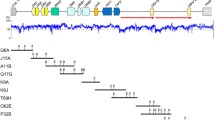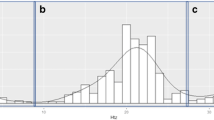Abstract
The major histocompatibility complex (Mhc) of domestic chickens has been characterized as small and relatively simple compared with that of mammals. However, there is growing evidence that the Mhc of many bird lineages may be more complex, even within the Order Galliformes. In this study, we measured genetic variation and balancing selection at Mhc loci in another galliform, the greater prairie-chicken. We cloned and sequenced a 239 bp fragment of Mhc Class II β-chain (BLB) exon 2 in 14 individuals. There was a total of 10 unique sequences and a minimum of four BLB loci. The d N/d S ratio at peptide-binding codons was significantly greater than one, suggesting balancing selection is acting on the BLB. We also recovered two YLB sequences, which clustered tightly with YLB sequences from three other species: domestic chicken, black grouse and common quail. The relatively large number of loci revealed in our study suggests that even closely related galliforms differ in the level of Mhc variation and structure.

Similar content being viewed by others
References
Afanassieff M, Goto RM, Ha J, Sherman MA, Zhong LW, Auffray C, Coudert F, Zoorob R, Miller MM (2001) At least one class I gene in restriction fragment pattern-Y (Rfp-Y), the second MHC gene cluster in the chicken, is transcribed, polymorphic, and shows divergent specialization in antigen binding region. J Immunol 166:3324–3333
Apanius V, Penn D, Slev PR, Ruff LR, Potts WK (1997) The nature of selection on the major histocompatibility complex. Crit Rev Immunol 17:179–224
Bellinger MR, Johnson JA, Toepfer J, Dunn P (2003) Loss of genetic variation in greater prairie chickens following a population bottleneck in Wisconsin, USA. Conser Biol 17:717–724
Bernatchez L, Landry C (2003) MHC studies in nonmodel vertebrates: what have we learned about natural selection in 15 years? J Evol Biol 16:363–377
Bonneaud C, Sorci G, Morin V, Westerdahl H, Zoorob R, Wittzell H (2004) Diversity of Mhc class I and IIB genes in house sparrows (Passer domesticus). Immunogenetics 55:855–865
Boonyanuwat K, Thummabutra S, Sookmanee N, Vatchavalkhu V, Siripholvat V (2006) Influences of major histocompatibility complex class I haplotypes on avian influenza virus disease traits in Thai indigenous chickens. Anim Sci J 77:285–289
Briles WE, Goto RM, Auffray C, Miller MM (1993) A polymorphic system related to but genetically independent of the chicken major histocompatibility complex. Immunogenetics 37:408–414
Brown JH, Jardetzky TS, Gorga JC, Stern LJ, Urban RG, Strominger JL, Wiley DC (1993) Three-dimensional structure of the human class-II histocompatibility antigen HLA-DR1. Nature 364:33–39
Burri R, Niculita-Hirzel H, Roulin A, Fumagalli L (2008) Isolation and characterization of major histocompatibility complex (MHC) class IIB genes in the barn owl (Aves: Tyto alba). Immunogenetics 60:543–550
Carrington M, O’Brien SJ (2003) The influence of HLA genotype on AIDS. Ann Rev Med 54:535–551
Chaves LD, Krueth SB, Reed KM (2007) Characterization of the turkey MHC chromosome through genetic and physical mapping. Cytogenet Genome Res 117:213–220
Dietert R, Dietert M (1991) The chicken major histocompatibility complex: structure and impact on immune function, disease resistance and productivity. In: Monographs in Animal Immunology, vol 1. Bar-Lab, Blacksburg
Edwards SV, Wakeland EK, Potts WK (1995) Contrasting histories of avian and mammalian Mhc genes revealed by class II B sequences from songbirds. Proc Natl Acad Sci USA 92:12200–12204
Edwards SV, Hess CM, Gasper J, Garrigan D (1999) Toward an evolutionary genomics of the avian Mhc. Immunol Rev 167:119–132
Garrigan D, Hedrick PW (2003) Perspective: Detecting adaptive molecular polymorphism: Lessons from the MHC. Evolution 57:1707–1722
Hall TA (1999) Bioedit is a user friendly sequence alignment editor and analysis program for Windows 95/98/NT. Nucleic Acids Symp. Ser. 41:95–98
Hess CM, Edwards SV (2002) The evolution of the major histocompatibility complex in birds. Bioscience 52:423–431
Hughes AL, Nei M (1988) Pattern of nucleotide substitution at major histocompatibility complex class-I loci reveals overdominant selection. Nature 335:167–170
Hughes AL, Nei M (1989) Nucleotide substitution at major histocompatibility complex class-II loci—evidence for overdominant selection. Proc Natl Acad Sci USA 86:958–962
Hughes AL, Yeager M (1998) Natural selection at major histocompatibility complex loci of vertebrates. Ann Rev Gen 32:415–435
Hughes CR, Miles S, Walbroehl JM (2008) Support for the minimal essential MHC hypothesis: a parrot with a single, highly polymorphic MHC class IIB gene. Immunogenetics 60:219–231
Hunt HD, Goto RM, Foster DN, Bacon LD, Miller MM (2006) At least one Y MHC I molecule in the chicken is alloimmunogenic and dynamically expressed on spleen cells during development. Immunogenetics 58:297–307
Janeway CA, Travers P, Walport M, Shlomchick M (2005) Immunobiology: the immune system in health and disease. Garland Press, New York
Johnson JA, Bellinger MR, Toepfer JE, Dunn P (2004) Temporal changes in allele frequencies and low effective population size in greater prairie-chickens. Mol Ecol 13:2617–2630
Kaufman J (2008) The avian MHC. In: KB DavisonF, Schat K (eds) Avian Immunology. Academic Press, London, pp 159–181
Kaufman J, Völk H, Wallny H-J (1995) A “minimal essential Mhc” and an “unrecognized Mhc”: two extremes in selection for polymorphism. Immunol Rev 143:63–88
Kaufman J, Milne S, Gobel TWF, Walker BA, Jacob JP, Auffray C, Zoorob R, Beck S (1999) The chicken B locus is a minimal essential major histocompatibility complex. Nature 401:923–925
Kim DK, Lillehoj HS, Hong YH, Park DW, Lamont SJ, Han JY, Lillehoj EP (2008) Immune-related gene expression in two B-complex disparate genetically inbred Fayoumi chicken lines following Eimeria maxima infection. Poul Sci 87:433–443
Kimura M (1983) The neutral theory of molecular evolution. Cambridge University Press, Cambridge
Klein J (1986) Natural history of the major histocompatibility complex. Wiley Press, New York
Klein J, Sato A, Nagl S, O’HUigin C (1998) Molecular trans-species polymorphism. Ann Rev Ecol Syst 29:1–21
Kriegs JO, Matzke A, Churakov G, Kuritzin A, Mayr G, Brosius J, Schmitz J (2007) Waves of genomic hitchhikers shed light on the evolution of gamebirds (Aves: Galliformes). BMC Evol Biol 7:11
Kroemer G, Guillemot F, Auffray C (1990) Genetic organization of the chicken Mhc. Immunol Res 9:8–19
Kumar S, Tamura K, Nei M (2004) Integrated software for molecular evolutionary genetic analysis and sequence alignment. Brief Bioinformatics 5:150–163
Longeri M, Zanotti M, Damiani G (2002) Recombinant DRB sequences produced by mismatch repair of heteroduplexes during cloning in Escherichia coli. Euro J Immunogenet 29:517–523
Miller HC, Lambert DM (2004) Genetic drift outweighs balancing selection in shaping post-bottleneck major histocompatibility complex variation in New Zealand robins (Petroicidae). Mol Ecol 13:3709–3721
Miller MM, Goto RM, Taylor RL, Zoorob R, Auffray C, Briles RW, Briles WE, Bloom SE (1996) Assignment of Rfp-Y to the chicken major histocompatibility complex NOR microchromosome and evidence for high-frequency recombination associated with the nucleolar organizer region. Proc Natl Acad Sci USA 93:3958–3962
Nadeau NJ, Burke T, Mundy NI (2007) Evolution of an avian pigmentation gene correlates with a measure of sexual selection. Proc R Soc B Biol Sci 274:1807–1813
Nei M, Gojobori T (1986) Simple methods for estimating the numbers of synonymous and nonsynonymous nucleotide substitutions. Mol Biol Evol 3:418–426
Nei M, Gu X, Sitnikova T (1997) Evolution by the birth-and-death process in multigene families of the vertebrate immune system. Proc Natl Acad Sci USA 94:7799–7806
Owen JP, Delany ME, Mullens BA (2008) MHC haplotype involvement in avian resistance to an ectoparasite. Immunogenetics 60:621–631
Pharr GT, Gwynn AV, Bacon LD (1996) Histocompatibility antigen(s) linked to Rfp-Y (Mhc-like) genes in the chicken. Immunogenetics 45:52–58
Piertney SB, Oliver MK (2006) The evolutionary ecology of the major histocompatibility complex. Heredity 96:7–21
Ploegh HL, Neefjes JJ, Stollorz V, Gehrmann M, Peters P, Geuze H (1990) The role of MHC molecules during activation of immune cells. Biol Chem 371:187
Rozas J, Sanchez-DelBarrio JC, Messeguer X, Rozas R (2003) DnaSP, DNA polymorphism analyses by the coalescent and other methods. Bioinformatics 19:2496–2497
Schou TW, Permin A, Juul-Madsen HR, Sorensen P, Labouriau R, Nguyen TLH, Fink M, Pham SL (2007) Gastrointestinal helminths in indigenous and exotic chickens in Vietnam: association of the intensity of infection with the major histocompatibility complex. Parasitology 134:561–573
Shiina T, Shimizu S, Hosomichi K, Kohara S, Watanabe S, Hanzawa K, Beck S, Kulski JK, Inoko H (2004) Comparative genomic analysis of two avian (quail and chicken) MHC regions. J Immunol 172:6751–6763
Shiina T, Hosomichi K, Hanzawa K (2006) Comparative genomics of the poultry major histocompatibility complex. Anim Sci J 77:151–162
Sommer S (2005) The importance of immune gene variability (MHC) in evolutionary ecology and conservation. Front Zool 2:16
Strand T, Westerdahl H, Hoeglund J, Alatalo RV, Siitari H (2007) The Mhc class II of the black grouse (Tetrao tetrix) consists of low numbers of B and Y genes with variable diversity and expression. Immunogenetics 59:725–734
Tajima F (1989) Statistical-method for testing the neutral mutation hypothesis by DNA polymorphism. Genetics 123:585–595
Tsuda TT, Tsuda M, Naruse T, Kawata H, Ando A, Shiina T, Fukuda M, Kurita M, LeMaho I, Kulski JK, Inoko H (2001) Phylogenetic analysis of penguin (Spheniscidae) species based on sequence variation in MHC class II genes. Immunogenetics 53:712–716
Wakenell PS, Miller MM, Goto RM, Gauderman WJ, Briles WE (1996) Association between the Rfp-Y haplotype and the incidence of Marek’s disease in chickens. Immunogenetics 44:242–245
Wallny HJ, Avila D, Hunt LG, Powell TJ, Riegert P, Salomonsen J, Skjodt K, Vainio O, Vilbois F, Wiles MV, Kaufman J (2006) Peptide motifs of the single dominantly expressed class I molecule explain the striking MHC-determined response to Rous sarcoma virus in chickens. Proc Natl Acad Sci USA 103:1434–1439
Westerdahl H (2007) Passerine MHC: genetic variation and disease resistance in the wild. J Ornithol 148:S469–S477
Westerdahl H, Wittzell H, von Schantz T (2000) Mhc diversity in two passerine birds: no evidence for a minimal essential Mhc. Immunogenetics 52:92–100
Wittzell H, Bernot A, Auffray C, Zoorob R (1999) Concerted evolution of two MHC class II B loci in pheasants and domestic chickens. Mol Biol Evol 16:479–490
Worley K, Gillingham M, Jensen P, Kennedy LJ, Pizzari T, Kaufman J, Richardson DS (2008) Single locus typing of MHC class I and class IIB loci in a population of red jungle fowl. Immunogenetics 60:233–247
Zelano B, Edwards SV (2002) An MHC component to kin recognition and mate choice in birds: Predictions, progress, and prospects. Am Nat 160:S225–S237
Zoorob R, Behar G, Kroemer G, Auffray C (1990) Organization of a functional chicken class-II B-gene. Immunogenetics 31:179–187
Zoorob R, Bernot A, Renoir DM, Choukri F, Auffray C (1993) Chicken major histocompatibility complex class II B genes: analysis of interallelic and inter-locus sequence variance. Eur J Immunol 23:1139–1145
Zorn AM, Krieg PA (1991) PCR analysis of alternative splicing pathways: identification of artifacts generated by heteroduplex formation. Biotechniques 11:180–184
Acknowledgments
Funding was provided by a Research Growth Initiative grant from the University of Wisconsin–Milwaukee Graduate School and the Wisconsin Department of Natural Resources to PD and LW and grants from the American Ornithologists’ Union and the Ruth Walker Research Award from the University of Wisconsin-Milwaukee to JE. We thank J. Toepfer, J. Johnson and R. Bellinger for tissue collection and processing and Erika Olson for assistance in the lab.
Author information
Authors and Affiliations
Corresponding author
Rights and permissions
About this article
Cite this article
Eimes, J.A., Bollmer, J.L., Dunn, P.O. et al. Mhc class II diversity and balancing selection in greater prairie-chickens. Genetica 138, 265–271 (2010). https://doi.org/10.1007/s10709-009-9417-4
Received:
Accepted:
Published:
Issue Date:
DOI: https://doi.org/10.1007/s10709-009-9417-4




